The warm, sunny days throughout May gave our heirloom tomato plants a good start into summer. Blossoms were spotted on every plant and we even saw a few tiny green tomatoes on the cherry varieties. How wonderful! It’s going to be a great tomato year…
And then it was June. And it was wet. And it was cold. And now, all those lovely blossoms that held the hope of a bounty of tomatoes in August, are dropping off the vines. What’s going on?? The dreaded early season blossom drop!
What is Blossom Drop?
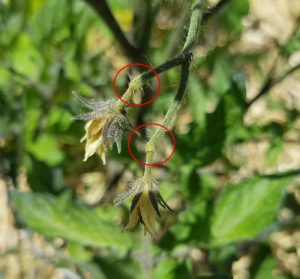
The red circles in this photo show a yellowing of the pedicel. These blossoms did not pollinate and will drop from the plant.
Blossom drop is exactly what is sounds like: The blossoms (flowers) fall off the plant due to some type of stress, either environmental (weather), cultural, or a combination of both.
Blossom drop is usually preceded by a yellowing of the pedicel — the section of the flower stem that once fruit is set, becomes the fruit’s stem.
Blossom drop, combined with our region’s short growing season, can cause a significant decrease in produce yields; you can actually see your harvest-potential shrivel before your eyes!
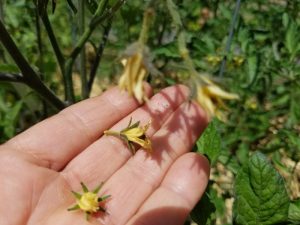
Dropped blossoms from an heirloom beefsteak tomato. Unstable weather conditions are often a cause of blossom drop.
Blossom drop occurs in many vegetable plants, but warm-season crops like peppers, eggplant, and tomatoes are most susceptible.
Tomatoes are especially finicky, fair-weather plants that require specific weather conditions to pollinate and set fruit. The “optimal” conditions are temperatures between 70°F and 85°F, with an ideal humidity range between 40% and 70%.
That was pretty much the weather we experienced in May and the earliest days of June, causing most of the tomato plants to blossom and begin to set fruit. However, the conditions that followed in June through early July were less than optimal (which is often the case in North Idaho).
Causes of Blossom Drop in Tomatoes
The most common, and often overlooked, reason for blossom drop in tomato plants is weather related. However, blossom drop can also occur due to cultural practices, such as inadequate watering and/or too much or too little available nitrogen.
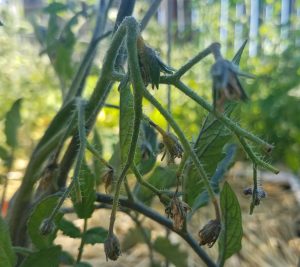
Temperatures below 55 degrees or above 90 degrees can cause blossom drop due to a lack of pollination.
The Weather: As noted above, tomatoes need warm temperatures both during the day and at night, to set fruit. The key here is warm — not hot, not cool, and especially not cold. Most tomato plants can tolerate a few days of temperatures above or below the optimal range, however, several days of extremely hot or cold temperatures cause pollen to become non-viable and eventually the blossoms die.
- Extended hot temperatures, those above 90°F during the day and 70°F during the night, will cause the cessation of pollination and cause blossom drop. Thankfully, we don’t experience these weather conditions in our region too often.
- Extended cool/cold temperatures, those below 55°F at night, also cause blossom drop. This is a very typical weather pattern for June in North Idaho, and is often the cause of blossom drop early in the season.
- Radical temperature swings from warm to cold, or warm to hot. For example consistent daytime temperatures in the 70s, followed by a sharp drop to 50°F (or lower) overnight, can cause blossom drop. Likewise optimal weather conditions, followed by a temperature spike to the upper 90s (or higher) can affect blossom drop.
- Humidity, either too high or too low, can interfere with pollen’s ability to be released or attach to the stigma. When pollination doesn’t occur, the blossom drops from the plant.
- Lack of sunlight can impact pollination and cause blossoms to drop. Tomatoes need at least 6 hours of sunlight. While there isn’t much we can do about extended cloudy days, make sure your plants are located where they will get 6 hours or more of sunlight, when it does shine!
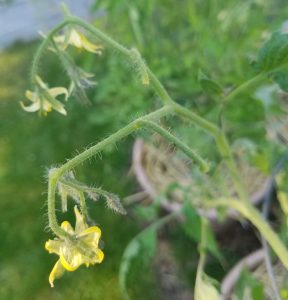
Viable blossoms can be found on bracts where others have dropped. Note the bare stems on this bract.
Unfortunately, we can’t control Mother Nature’s weather, but there are a few things that might help prevent blossom drop due to weather.
- When low temperatures are predicted, use floating row covers to protect plants. Likewise, row covers can be used to provide shade when temperatures soar.
- Choose tomato varieties that will set fruit in a wider temperature range. This are often cherry tomato types and “early” varieties well suited for cool growing climates. Large beefsteak tomatoes tend to be the most susceptible to temperature variations outside the optimal conditions.
- If possible, stagger plantings so not all of your plants are blossoming at the same time. This can be difficult in our short growing season, but it’s worth a try.
Cultural Issues: Blossom drop can also be caused by poor cultural practices, including watering, fertilization, and pest or disease management.
- Lack of adequate water is another reason for blossom drop in tomatoes. Plants have deep roots, which when given the chance, can reach 5 feet or more into the soil. Lack of water stresses the plant and blossoms will drop. It’s much better to water deeply once a week, than to provide a sprinkling of water on a daily basis. The root zone should be moist throughout the growing season — mulch and water deeply!
- Too much or too little nitrogen will also cause blossom issues. If too much nitrogen is applied, your plants will be lush and green, but won’t produce blossoms at all. Too little, and the plant won’t have the necessary nutrients to set fruit. It’s very important to READ and FOLLOW the instructions when using any type of fertilizer — organic or synthetic. It’s also a good idea to have the soil tested before you randomly begin to apply soil amendments in the spring. A good soil test (from your local Extension office), will tell you what, if anything, you soil is lacking for nutrients.
- Pest and disease can also cause poor blossom development or drop. Treating symptoms early or removing diseased plants can stop the spread. Again, it is essential to READ and FOLLOW the directions if you choose to use a chemical — either organic or synthetic.
The Good News
All is not lost when you see blossom drop. While it’s frustrating and a bit of a setback, your healthy tomato plants will continue to put out blossoms.
As summer’s temperatures stabilize to those optimal conditions, fruit will set and grow. Plus any fruit that set during those warmer days of May will continue to grow (we’re just days away from our first ripe cherry tomato!!).
Now, we just need Mother Nature to cooperate and give us a nice long, warm summer and fall, so all of those late-set tomatoes will have time to ripen!
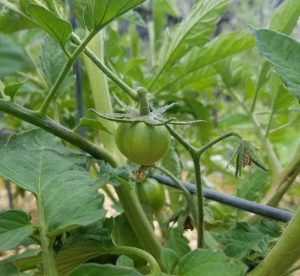



Great post! Very informative. We didn’t do our raised beds this year, mostly because of Chris’ accident, so I did three tomato plants and two pepper plants in containers on the deck. Would you believe they are my most vibrant and productive vegetable plants EVER?!? ????
Yes, I would believe that, since they are most likely in exceptional potting soil and if you are fertilizing, they are the only plants utilizing the nutrients! Many times plants in pots perform better because of these two things — soil/fertilizer, lack of competition. Glad to hear your mini garden is doing well!
Great post! Very informative.
Thanks.